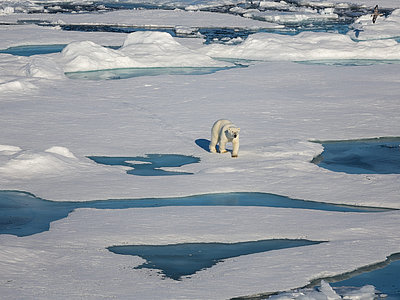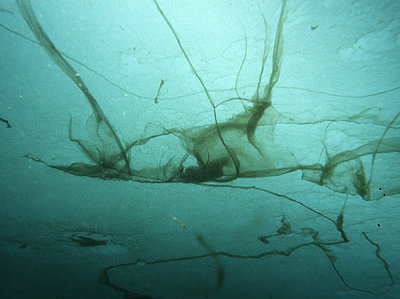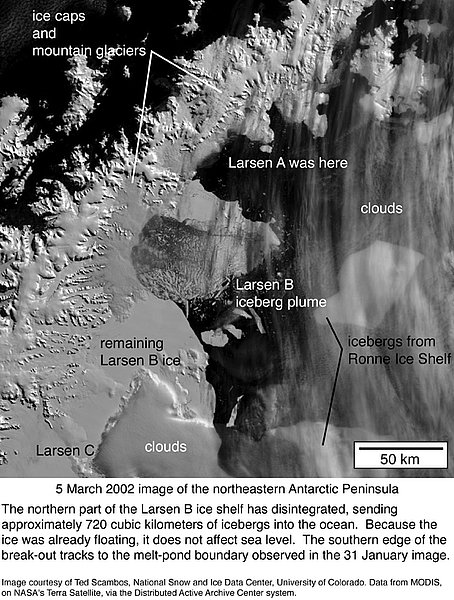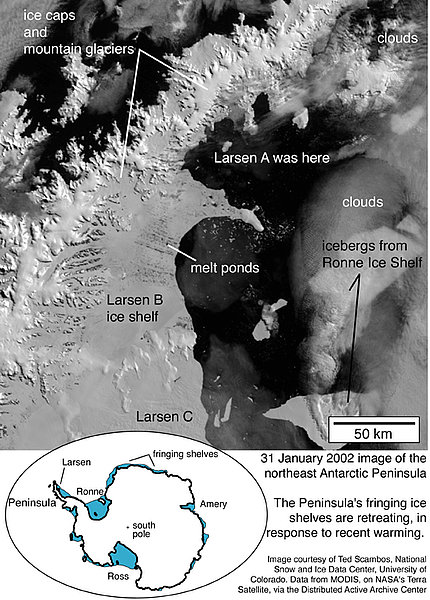Benthos


The changes in the sea ice and at the ocean’s surface in general also affect life at the sea-floor. First and foremost, what is important is the amount of food that reaches the seafloor from the productive, well-lit layer near the surface, providing energy for the organisms living there, the so-called benthos. Light also plays an important role in shallow ocean areas. When the sea ice disappears, more light reaches the seafloor, which can e.g. lead to increased algal growth. In the shallow coastal areas in the Arctic, the amount of large brown algae, several-metre-long kelp that offers important habitats for fishes and marine mammals, has increased in the last two decades. The reasons for this are the greater availability of light due to the thinner ice cover, and the warmer water masses. In addition, the plants are less frequently scraped off the seafloor by pressure ridges or icebergs (IPCC, 2019).
The algae that sink to the seafloor from the ice are an important energy source for the benthos. Added to this is e.g. excrement from small crustaceans. Especially large amounts of food reach the seafloor when, in early spring, the diatom Melosira arctica rapidly reproduces. This creates long strands beneath the ice, which then gradually detach and sink to the depths (Lannuzel et al., 2020).
In the future, meltwater ponds could become a dominant feature of the sea ice in spring. Since they allow more light to penetrate the ice, this could promote the development of dense Melosira colonies. In turn, the sinking algal strands could amplify the episodic nutrient input at the seafloor. However, the farther the ice retreats, the less ice-algae mass will be produced. Therefore, experts assume that the amount of available biomass for the benthos will decrease in the future. Although in many regions of the Arctic, primary production by free-swimming algae will increase due to areas of open water and greater light availability, this won’t be enough to compensate for the loss of algal mass (Lannuzel et al., 2020). The result will be a decrease in biomass at the seafloor.
Such a development has already been observed in the Bering Sea and Chukchi Sea in the North Pacific. In the Barents Sea, north of Norway, on the other hand, it has been observed that the composition of the benthic fauna has been changing for several years. It is assumed that several factors interact here: sea-ice retreat, greater mixing of the water, ocean acidification, and higher temperatures at the seafloor. Something similar is currently happening in the fjords of Svalbard. Here the typical Arctic fauna at the stony seafloor are changing because, for years, a number of fjords have been ice-free in summer and the water temperature has increased (IPCC, 2019).
How significantly the changes at the seafloor influence the stocks of animals that live there and feed on benthic organisms is still uncertain. Off Newfoundland, Labrador and Nova Scotia, the number of snow crabs has decreased. At the same time, stocks in the Barents Sea are increasing. It is unclear how changes in the benthos will affect mammals like the walrus and grey whale, which mainly find their food at the seafloor (IPCC, 2019).
Cavan, E.L., A. Belcher, A. & A. Atkinson et al. (2019): The importance of Antarctic krill in biogeochemical cycles. Nat Commun 10, 4742. doi.org/10.1038/s41467-019-12668-7
Grosfeld, K. , R. Treffeisen & S. Löschke (2020): DriftStories aus der zentralen Arktis - Ein Jahr, eine Scholle - Meereisforschung extrem / K. Grosfeld , R. Treffeisen and S. Löschke (editors), Bremerhaven, REKLIM - Helmholtz-Verbund Regionale Klimaänderungen und Mensch, 106 p., ISBN: 978-3-9822680-0-2.
Henley, S.F. et al. (2020): Changing Biogeochemistry of the Southern Ocean and Its Ecosys-tem Implications. Frontiers in Marine Science, 7, 581.
IPCC, 2019: IPCC Special Report on the Ocean and Cryosphere in a Changing Climate [H.-O. Pörtner, D.C. Roberts, V. Masson-Delmotte, P. Zhai, M. Tignor, E. Poloczanska, K. Mintenbeck, A. Alegría, M. Nicolai, A. Okem, J. Petzold, B. Rama, N.M. Weyer (eds)].
Lannuzel, D., L. Tedesco & M. van Leeuwe et al. (2020): The future of Arctic sea-ice bio-geochemistry and ice-associated ecosystems. Nat. Clim. Chang. 10, 983–992. doi.org/10.1038/s41558-020-00940-4
Maribus gGmbH (Ed.) (2019): Arktis und Antarktis – extrem, klimarelevant, gefährdet. In: World Ocean Review, Band 6.
Massom R. A., et al. (2010): Antarctic sea ice change and variability e Physical and ecologi-cal implications. Polar science 4, 149-186.
Unlike in the Arctic, it is expected that in the Antarctic the amount of biomass available to the benthos will increase. This is because the sea ice has been declining for several years, especially in the western Antarctic, and as a result there is more open water available for primary production. In the last 50 years, sea-ice loss and the decline in glaciers have meant that there are an additional 24,000 square kilometres of open water in the western Antarctic alone. The calving of a huge iceberg and the disintegration of entire shelf regions, such as at the Larsen-B Ice Shelf in 2002, have added to this. We are gradually beginning to understand the biology at the seafloor. The dense ice masses mean that in many regions there is permanent darkness there. If the ice shelf disappeared, light could penetrate. This would lead to a tremendous growth in algae and kelp. With the loss of sea ice, not only would algal blooms increase, but the composition of the zooplankton and other benthic species communities would also change (Massom et al., 2010).
As a rule, the benthic communities in shallow coastal areas that are permanently covered by ice largely consist of invertebrates that are adapted to the darkness. If the amount of light increases, major changes will ensue. Above all, the invertebrate communities will be replaced by kelp-dominated species communities. Using computer models, experts have concluded that, with continuing high carbon dioxide emissions through the end of the century, up to 79% of endemic benthic organisms could be affected by these changes, in that they could withdraw from several ocean regions. Taking the average for nearly 1,000 fauna species, their stocks would decrease by at least 12 percent. However, even greater losses are expected for the especially hard-hit regions of the Antarctic Peninsula and adjacent Scotia Sea (IPCC, 2019).
Generally speaking, the waters of the Antarctic are not only expected to produce more algal biomass; their benthic communities, thanks to the higher biomass input, will also likely bind more carbon (IPCC, 2019).


Cavan, E.L., A. Belcher, A. & A. Atkinson et al. (2019): The importance of Antarctic krill in biogeochemical cycles. Nat Commun 10, 4742. doi.org/10.1038/s41467-019-12668-7
Grosfeld, K. , R. Treffeisen & S. Löschke (2020): DriftStories aus der zentralen Arktis - Ein Jahr, eine Scholle - Meereisforschung extrem / K. Grosfeld , R. Treffeisen and S. Löschke (editors), Bremerhaven, REKLIM - Helmholtz-Verbund Regionale Klimaänderungen und Mensch, 106 p., ISBN: 978-3-9822680-0-2.
Henley, S.F. et al. (2020): Changing Biogeochemistry of the Southern Ocean and Its Ecosys-tem Implications. Frontiers in Marine Science, 7, 581.
IPCC, 2019: IPCC Special Report on the Ocean and Cryosphere in a Changing Climate [H.-O. Pörtner, D.C. Roberts, V. Masson-Delmotte, P. Zhai, M. Tignor, E. Poloczanska, K. Mintenbeck, A. Alegría, M. Nicolai, A. Okem, J. Petzold, B. Rama, N.M. Weyer (eds)].
Lannuzel, D., L. Tedesco & M. van Leeuwe et al. (2020): The future of Arctic sea-ice bio-geochemistry and ice-associated ecosystems. Nat. Clim. Chang. 10, 983–992. doi.org/10.1038/s41558-020-00940-4
Maribus gGmbH (Ed.) (2019): Arktis und Antarktis – extrem, klimarelevant, gefährdet. In: World Ocean Review, Band 6.
Massom R. A., et al. (2010): Antarctic sea ice change and variability e Physical and ecologi-cal implications. Polar science 4, 149-186.
Scambos, T.A., Hulbe, C., Fahnestock, M., and Bohlander, J., 2000, The link between climate warming and break-up of ice shelves in the Antarctic Peninsula, Journal of Glaciology, 46 (154), 516-530.
Figure: web.pdx.edu/~chulbe/science/Larsen/larsen2002.html
Ted Scambos, National Snow and Ice Data Center, University of Colorado. Data from MODIS (NASA Terra Satellite) via the Distributed Active Archive Center)
